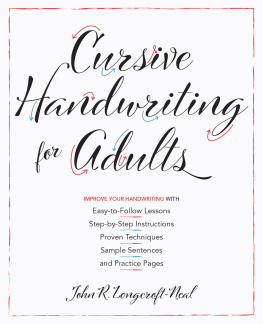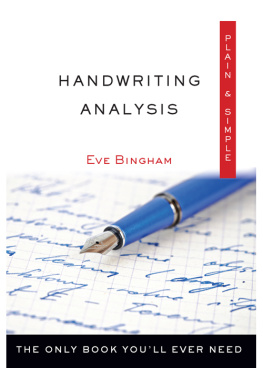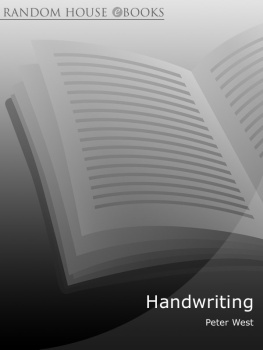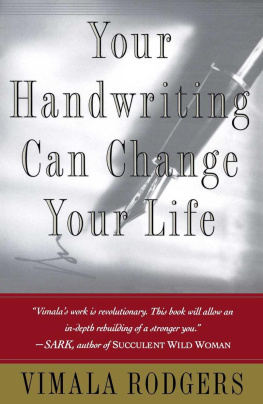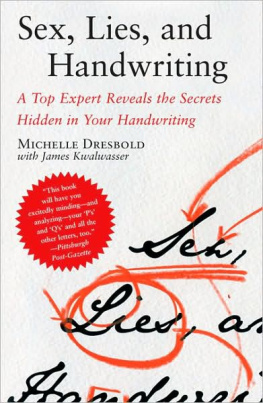THE HISTORY AND UNCERTAIN
FUTURE OF HANDWRITING
BY THE SAME AUTHOR
A Skeptics Guide to Writers Houses

I never saw a hotter argument on so unexciting a subject.
Erasmus, 1528, On Handwriting
CONTENTS
Ellie was sitting at her desk, across from Max and next to Isabel, writing in a small stapled book with a green cover. She had written the title How the World Works in large outlined letters and then colored them in using the blue, red, and green markers on her desk. Inside were twelve pages on which she had written in large, neat printed letters.
Ellie (a pseudonym) is a second grader, and I was hanging out in her classroom during the Tuesday morning literacy block of Ms. Hammers class at an elementary school in Shaker Heights, Ohio. I was there recently to observe a typical handwriting lesson in American public schools.
At the beginning of class, I had watched Ellie go to one of the four computers and type in her username to use Success Maker, a reading program featuring bears that drum when a child gets an answer right. After Ellie finished writing in her book, I squatted next to her and asked her a question: Which do you prefer, handwriting or typing?
She thought for several moments, staring at me with a somewhat confused look on her face. Her eyes rolled up towards the ceiling as she contemplated such an odd question, then looked back down at me.
Writing.
Why? I followed up.
Because when you go to the computer, you have to find a letter and you dont know where it is.
I was surprised by her answer, because at the beginning of the class, all the kids, including Ellie, had raised their hands when asked who wanted to have a turn at the computer. I assumed that, for them, the novelty and ease of keyboarding would be more fun.
When I polled some of Ellies other classmates, they were equally divided on the question and had a variety of reasons for preferring one method of making letters to another: Typing is more fun, said one. Writing is quicker, said another.
A few minutes later Ellie looked back at me. She had changed her mind. But when you write, your hands hurt, because you have to hold the pencil.
Ellie and the other kids in Ms. Hammers class, like many of us, can find pros and cons with the two types of writing instruments in their classroom, pencils and computers. The fact that both handwriting and typing are equal players in Ellies education speaks to the fact that we are all living through a historic moment in the history of writing: the shift from one technology to another. Ellie and her classmates are at the center of this storm, because they are going to elementary school now, and kindergarten through third grade are the years in which one is typically taught handwriting. Ellie is both lucky and unlucky to be in the middle of this transition. She has two ways of writing at her disposal at a younger age than most Americans have had: she can both type and print. But there is no clear consensus as to what she should be taught. Just printing? Printing and cursive? Or even just keyboarding? In a world where you can electronically sign your tax return and where we predominantly use phones for written communication, perhaps Ellie does not need to learn how to use a pencil at all. After all, it makes her hand hurt.
But the prospect of not teaching students handwriting strikes many as unimaginable. The three Rsreading, riting and rithmetichave been a core part of American education for as long as any of us can remember. The thought of altering that precept of schooling seems threatening to many, not just because change is often difficult, but because people often carry with them a host of larger associations with handwriting. The ability to write by hand is connected to core values: an educated person must know cursive, some believe. Signing ones name authenticates one as an individual, a unique person. Civilized peoples must teach their children this skill.
These are powerful beliefs, but they are historically and culturally specific. The three Rs are themselves an invention of the past century. Many civilized cultures have not developed handwriting. One could consider handwriting as simply one way to make letters, a neutral technology, and conclude that the way we make them is of little import. After all, no one is suggesting we stop teaching the expression of ideas through written language. This shift from handwriting to keyboarding could be seen as innocuous as, say, teaching high schoolers how to drive only cars with automatic transmissions.
However, since handwriting is bound up with connotations that propel it beyond being simply a fine motor skill, the prospect of its disappearance is threatening and anxiety producing. The current shift from one writing technology to another is as jarring and culturally significant as when the printing press was invented. In the sixteenth century, monks decried the horrors of printed books, which they were sure would be full of mistakes. Today we find ourselves unsure of handwritings future, and it has become the focus of a very similar anxiety. Will people who text a lot become less literate? Does Twitter spell the end of complex, lengthy writing?
These anxieties and worries arent new to the twenty-first century, and if history is any guide, new technologies do not kill off previous ones. Writing did not kill speech, but speaking took on new valences as writing came to compete with it; indeed, the ancient Greeks argued orality was a more complex form of communication than writing. We see this happening now, as handwriting is lauded as something that embodies positive personal qualities: rigor over facile information processing, individual emotion over impersonal mechanization.
Writing of any kindbe it on computer, on a typewriter, on papyrus, or as I compose.
So should Ellie learn cursive? Probably not. It will only really prepare Ellie for third grade, not life. But the history of handwriting is replete with lessons once taught to generations now forgottenand some that resonate with us anew. Children have been learning to write for some six thousand years. In those early classrooms, teachers taught how to press wedge-shaped marks into wet clay. As unfamiliar a way to learn ones letters as that might sound, the tablets they produced have much in common with how many of usincluding second graderswrite today.
as it returns us to the realm of speaking, something most humans learn autonomously, whereas writing must be taught.
Cuneiform, humanitys first writing system, was invented some five thousand years ago in what is now southern Iraq, and it was most often written on clay tablets a few inches square and an inch thick. Hundreds of thousands of tablets have been discovered by archaeologists over the centuries, and they are held by many museums and libraries around the world, including the Morgan Library & Museum in New York. When I visited the Morgan to view cuneiform, Sidney Babcock, curator and department head, Ancient Near Eastern Seals & Tablets, invited me to pick one up. Really? I can touch it? I asked. Absolutely, he responded. The oil on your hands wont hurt them. And they wont breaktheyve lasted this long!
To be so close to these tablets, which are mind-bogglingly old, was stunning. Vellum, parchment, papyrus, and paperother writing surfaces people have used in the pastdeteriorate easily. But not clay, which has proven to be the most durable, and perhaps most sustainable, writing surface humanity has ever employed.
Gingerly, I brought the tablet close to my eyes. The clay was cool to the touch. Palm-sized and pale brown, it was full of tiny incisions. Although I had seen images of cuneiform before my visit to the Morgan, I underestimated how much the reproductions had been magnified. I imagined the tablets would be the size of my iPhone, but most were half that. And the marks were tiny. Babcock used this analogy to describe the size of the writing: Find the second portrait of Lincoln on the penny. You know, the one of his statue inside the Lincoln Memorial on the obverse? Thats how small the script can be.
Next page



